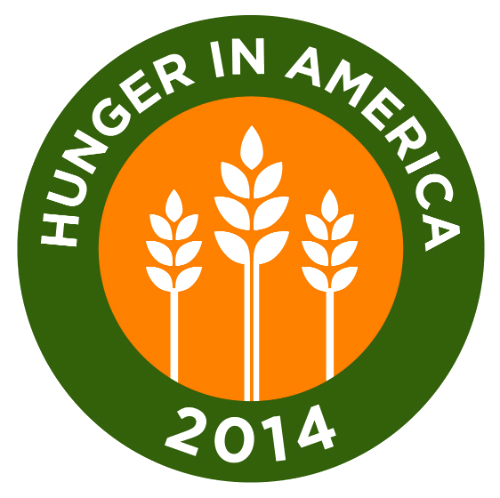Hunger in America is a series of quadrennial studies that provide comprehensive demographic profiles of people seeking food assistance through the charitable sector and an in-depth analysis of the partner agencies in the Feeding America network that provide this assistance. It is the largest study of its kind. The data collected through the Hunger in America studies help guide the development of programs and solutions that improve food security for individuals and their households and inform public policy and support for solving hunger in America.
Hunger in America 2014 is the sixth and most comprehensive study undertaken. The 2014 study reveals that each year, the Feeding America network of food banks provides service to 46.5 million people in need across the United States, including 12 million children and 7 million seniors. Through a network of 58,000 pantries, meal service programs, and other charitable food programs, the Feeding America network reaches people in need in every community across the U.S.
Key Findings
One in seven Americans turns to the Feeding America network for food assistance.
Feeding America, through its network of 200 food banks and 58,000 feeding programs, provides food assistance to 46.5 million people in the U.S., including 12 million children and 7 million seniors.
 Each week, the Feeding America network serves 5.4 million individuals.
Each week, the Feeding America network serves 5.4 million individuals.- Thirty-nine percent of client households have a child under age 18.
- One in three client households has a senior household member 60 years or older.
Low wages, underemployment and unemployment may drive need for food assistance.
- The median monthly household income of Feeding America network clients is $927.
- More than half of client households (54%) report at least one employed person at some point in the past year.
- Among households with an employed person, the individual with the longest employment duration is more likely to be employed part-time (57%) than full-time (43%).
- Nearly three-quarters of Feeding America households (72%) live at or below the poverty line.
Many Feeding America clients are educated beyond high school while many adult clients are currently enrolled in school.
- Forty-one percent of households have a member with more than a high school education.
- More than one in four adult clients have more than a high school education.

For the first time, the Hunger in America study asked about U.S military service.
- One in five (20%) of households served by the Feeding America network has at least one member that has ever served in the military.
- Nearly 620,000 households (4 percent of households served by the Feeding America network) have at least one member who is currently serving in the U.S. military Active Duty, Reserves or National Guard.

To learn more about Hunger in America 2014 military statistics, please see the memo entitled Hunger in America 2014: Military Service in Feeding America Client Households [pdf]
Feeding America’s client population faces significant health challenges, including diabetes and high blood pressure.

- 77 percent of client households with seniors have a member(s) with high blood pressure, and nearly half (47 percent) have a member(s) with diabetes.
- 79 percent of client households report purchasing the cheapest food available, even if they knew it wasn’t the healthiest option, in an effort to provide enough food for their household.
Feeding America client households frequently face difficult decisions in an effort to ensure they have sufficient food.
- Client households often survive on limited budgets and are confronted with choices between paying for food and paying for other essentials. These dilemmas can put households in the position of choosing between competing necessities.

- In addition to charitable nutrition assistance programs and making spending tradeoffs, many households also engage in a number of other coping strategies in order to feed their families.

Feeding America network agencies and programs

- In a typical month, nearly 2 million volunteers contribute more than 8.4 million hours of their time to food programs across the Feeding America network. That’s more than 100 million hours of donated labor across the Feeding America network over the course of a year.
- In addition to Feeding America’s core services of food distribution, many agencies also operate non-food programs that provide assistance in the form of clothing and furniture, legal aid, housing assistance, and general referrals. Between both food and non-food programs, nearly 100,000 are operated by agencies with 32% of agencies offering both program types.

